Penglai Pavilion (蓬莱阁), located on Danya Mountain in Yantai, was built in the sixth year of the Northern Song Dynasty’s Jiayou era (1061 AD). It has been renovated multiple times throughout history but has never been rebuilt, retaining its original Northern Song architectural style. Known for the legend of the “Eight Immortals Crossing the Sea” and the phenomenon of mirages, Penglai Pavilion is celebrated as a “paradise on earth.” It is one of the “Four Great Towers of China,” alongside Yueyang Tower in Hunan, Tengwang Pavilion in Nanchang, Jiangxi, and Yellow Crane Tower in Wuhan, Hubei, and is often called the “First Pavilion North of the Yangtze.”
From the pavilion, visitors can gaze out to the meeting point of the Yellow Sea and the Bohai Sea, where the boundary between the yellow and blue waters is strikingly clear. Additionally, the distant Changdao Islands can be seen.
The complex of Penglai Pavilion includes several different temples, halls, pavilions, and towers, such as the Baiyun Palace’s Sanqing Hall, Lvzu Hall, Su Gong Ancestral Hall, Tianhou Palace, Dragon King Palace, the main Penglai Pavilion building, and Amitabha Temple. Collectively known as the Penglai Pavilion complex, it covers a total area of 32,800 square meters, with a total building area of 18,960 square meters.
Table of Contents
- Basic Information
- Location and Transportation
- Map of Penglai Pavilion Scenic Area
- Highlights of Penglai Pavilion Scenic Area
- Legends about Penglai pavilion
- Vlog about Penglai Pavilion Scenic Area
- History of Penglai Pavilion
- Attractions near Penglai Pavilion
Basic Information
| Estimated Length of Tour | 2 hours |
| Ticket Price | 100 RMB |
| Opening Hours | 8.00 – 17.30; Last admission: 16.30 (1st January – 30th April) 7.00 – 18.00; Last admission: 17.00 (1st May – 5th May) 8.00 – 18.00; Last admission: 17.00 (6th May – 31st December) |
| Telephone Number | 0086-0535-5621111 |
Location and Transportation
Penglai Pavilion is located atop Danxia Mountain, at 7 Yingbin Road, Penglai District, Yantai City, Shandong Province, China. To get there, you can take bus Penglai 2, Penglai 10, Penglai 3, Penglai 4, Penglai 5, Penglai 6, Penglai 7, Penglai 8, or Penglai 9 and get off at Penglai Pavilion West Stop (蓬莱阁西站)
Map of Penglai Pavilion Scenic Area

Highlights of Penglai Pavilion Scenic Area
The Architecture of Penglai Pavilion

Penglai Pavilion is renowned for its striking architecture and the legends associated with it. The main structure of Penglai Pavilion is situated centrally at the back of the complex. Standing 15 meters tall, the pavilion faces south and features a two-story wooden structure with double eaves and an octagonal design. The pavilion is surrounded by a bright red veranda, providing visitors with a panoramic view and an excellent spot to observe the extraordinary mirage phenomenon.
The ground floor of Penglai Pavilion measures 14.8 meters in length and 9.65 meters in depth, with corridors on all sides and sixteen visible pillars. A replica of the giant plaque reading “蓬莱阁” hangs above the main entrance. Originally, the interior walls were adorned with poems, inscriptions, and paintings from various historical periods, although these have not survived. On the exterior north wall of the ground floor, three stone inscriptions are embedded, bearing the phrases “碧海清风 (Blue Sea and Clear Wind),” “海不扬波 (The Sea is Calm),” and “寰海镜清 (Mirror of the World).”
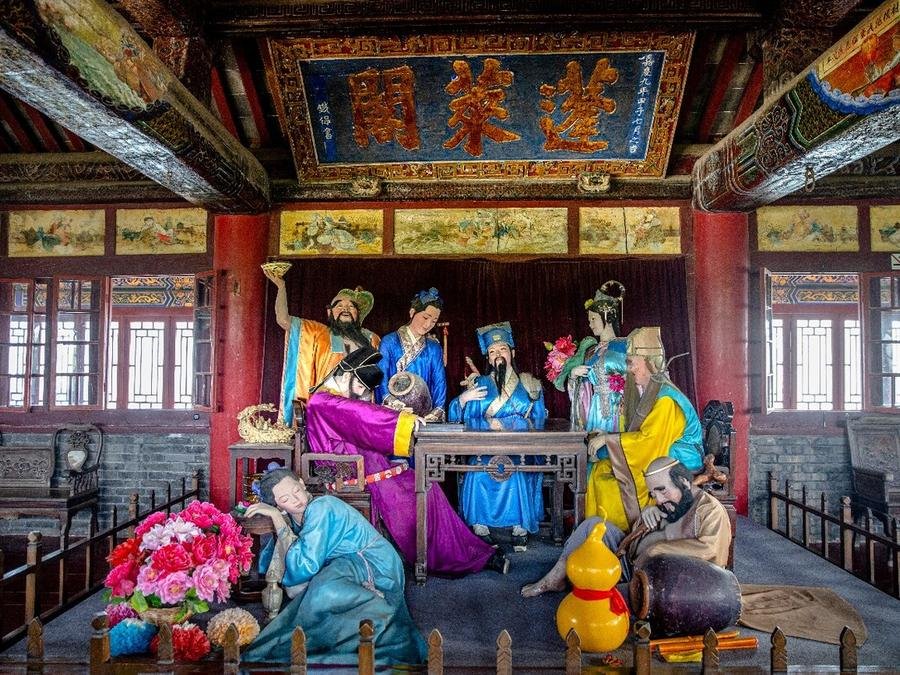
The second floor of the pavilion measures 13.75 meters in length and 8.55 meters in depth. It also features corridors on all sides, sixteen visible pillars, wooden lattice railings, and wooden screens on the north, east, and west sides. The northern side has windows offering a view of the sea. The second-floor entrance faces south, with a plaque outside reading “碧海春融 (Spring in the Blue Sea)” and another inside reading “神州胜境 (A Beautiful Land of Wonder).” The north wall inside prominently displays the original “蓬莱阁” plaque, written by the famous Qing Dynasty calligrapher Tiebao. The wooden beams and columns inside are decorated with paintings depicting the “Ten Views of Penglai,” the “Eight Immortals,” and “Wind and Bamboo.”
The second floor is also furnished with eight immortals tables and chairs, and at the center is a sculptural group called “The Eight Immortals Drunk,” inspired by the legend of the “Eight Immortals Crossing the Sea.” This artwork portrays the immortals reveling at Penglai Pavilion, each demonstrating their supernatural abilities after becoming intoxicated.
Amitabha Temple
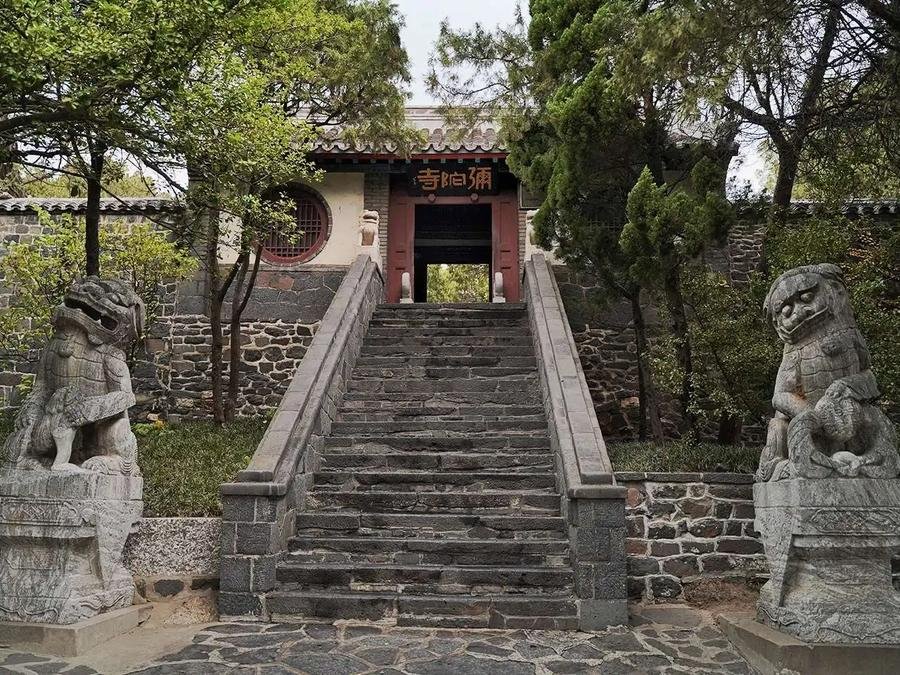
Located on the southern slope of Mount Danya, the Amitabha Temple (弥陀寺) is a traditional temple-style structure with a brick and wood design, gradually descending from north to south. It was initially constructed during the Tang Dynasty’s Zhenguan period and was once a thriving Buddhist temple. Over time, with the rise of Taoism at Penglai Pavilion, the temple’s prominence waned. Today, the temple complex includes the front hall, main hall, and east and west wing rooms.
The front hall measures 8.93 meters in length and 4.9 meters in depth, while the main hall is 9.82 meters long and 8.85 meters deep. In front of the main hall, there is an east-west oriented corridor leading to round corner gates. The east and west corner gates are inscribed with “蓬壶 (Penglai)” on the outer side and “胜境 (Wonderland)” on the inner side. Inside the main hall, four golden pillars support the structure, and the north wall prominently displays the inscription “天风海涛 (Heavenly Wind and Sea Waves),” personally written by the famous artist Liu Haisu.
The hall is adorned with over ten pieces of intricately carved rosewood furniture and a pair of colorful silk-embroidered screens depicting the Eight Immortals. The walls are decorated with calligraphy and paintings by renowned artists, adding to the temple’s cultural richness.
Dragon King Palace
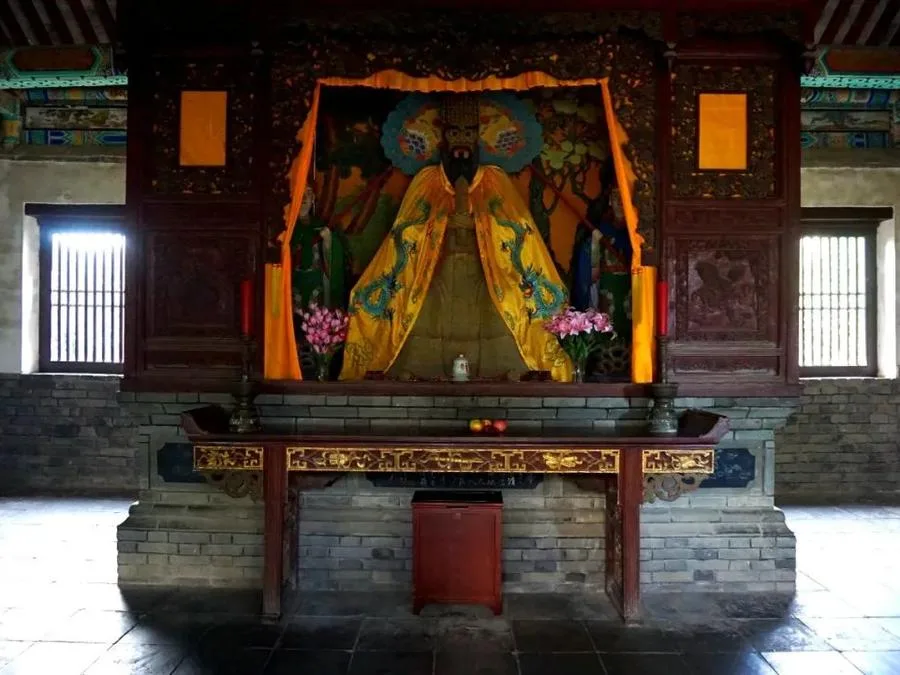
Originally located at the summit of Mount Danya, the Dragon King Palace (龙王宫), also known as Guangde King Temple, was built during the Tang Dynasty’s Zhenguan period. The palace covers a total area of 2,117 square meters. Inside the front hall, there are statues of two sea guardians: the East Sea God and the West Sea God, each holding a sacred treasure.
The main hall, measuring 12.69 meters in length and 10.08 meters in depth, features a high platform shrine housing a golden statue of Ao Guang, the Dragon King of the East Sea. On either side of the Dragon King are eight standing officials, each with distinct roles: from south to north, on the east side are the Sea Patrol Yaksha, Thousand-Mile Eye, Mother of Lightning, and Thunder God; on the west side are the Fish Herding Youth, Wind-Ears, Wind Mother, and Rain God.
The rear hall serves as the Dragon King’s sleeping quarters, with another high platform shrine containing statues of the Dragon King and his consorts. Additionally, the hall features statues of eight female attendants, four on each side. Though the original wooden carvings of the Dragon King and ceremonial items such as the sedan chair and regalia no longer exist, the remaining structures and statues continue to convey the palace’s historical and religious significance.
Zisun Hall (Children and Grandchildren Hall)
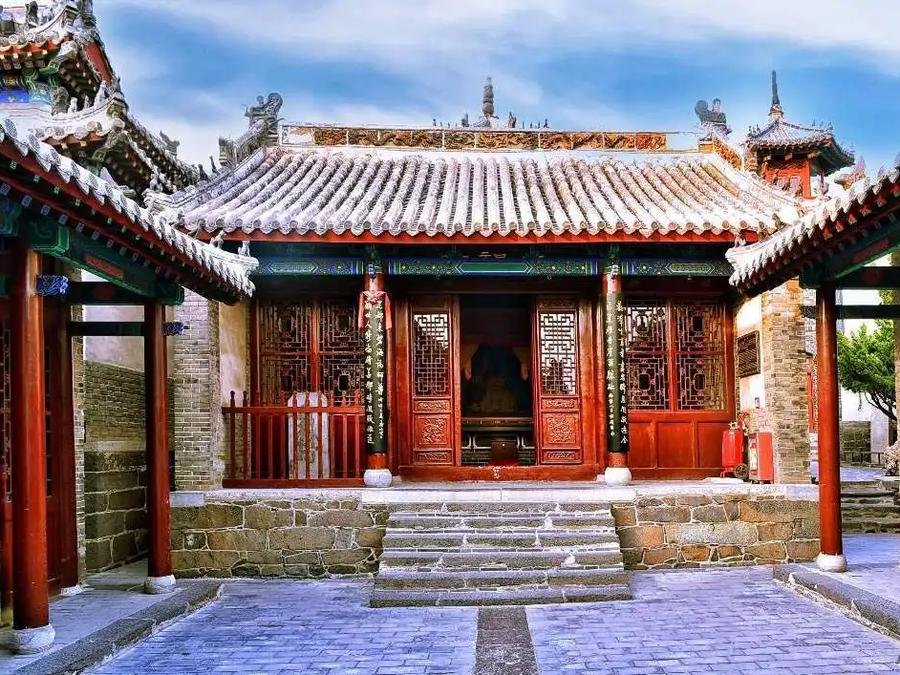
Located to the east of the main hall of the Dragon King Palace, Zisun Hall’s (子孙殿) entrance is adjacent to the northwest ear gate of the first courtyard of Tianhou Palace. This temple-style building is adorned with a plaque above its gate inscribed with “熊罴赐梦 (Xiong Bi Bestows Dreams).” Inside, the hall is equipped with mats and incense burners. On the south side of the front door inside the main hall, there is a “Treasure Pavilion” depicted on the wall. The hall is surrounded by high platforms on the east, north, and west sides. The northern high platform houses three linked shrines. The central shrine enshrines a statue of the Goddess of Children, while the eastern and western shrines house statues of the Goddess of Vision and the Goddess of Smallpox, respectively. The eastern and western high platforms feature sculptures of Kirin and Heavenly Kings, symbolizing blessings for offspring. Zisun Hall primarily venerates the Goddess of Children, believed to bless children with clear minds, lofty aspirations, and smooth passage through the challenges of life.
Tianhou Palace (Heavenly Queen Palace)

Situated east of Zisun Hall, Tianhou Palace (天后宫) occupies an area of over 3,000 square meters and follows a symmetrical layout with a central axis. It consists of four courtyards: the main gate, the bell and drum towers, the opera stage, the front hall, the hanging flower gate, the east and west wings, the main hall, the east and west side halls, and the rear hall, all built in the traditional temple style. The principal deity worshiped here is Lin Mo, the female sea goddess. Tianhou Palace’s main gate boasts three beams, integrated with the palace walls, and is adorned with the inscription “显灵 (Manifestation of Spirits).” On the eastern side of the gate, there is a relief sculpture of a stone Buddha made from White Marble, known to date back to the Tang Dynasty.
Within the first courtyard south of the main entrance of Tianhou Palace, there are bell and drum towers on both sides. The bell tower is located to the east, and the drum tower to the west, both designed as temple-style pavilions. Adjacent to the north passageway between the bell and drum towers are three stone steles inscribed with “坤爻石记” (Records of Kun Yao Stones), “松石亭记” (Records of Song Shi Pavilion), and “重修白云宫、海神庙、天后宫、蓬莱阁记 (Reconstruction of Baiyun Palace, Sea God Temple, Tianhou Palace, and Penglai Pavilion).”
Ancient Opera Stage
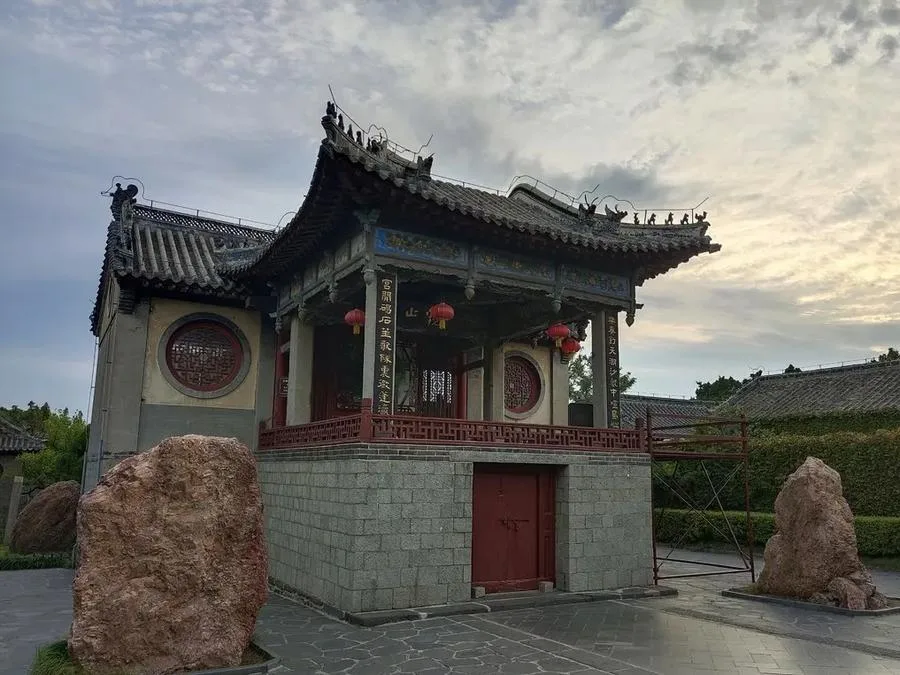
Located centrally within the first courtyard, the Ancient Opera Stage is a two-story temple-style building made of wood and stone, facing north. It features a door on the first floor that runs north to south, providing access to the front hall of Tianhou Palace. The southern half of the second floor serves as a dressing and resting area for actors, while the northern half houses the stage itself. The stage is supported by four stone columns adorned with hanging pearl curtains, and above the northern eaves hangs a plaque reading “观止 (Enjoy the Spectacle).” During the annual temple fair on the 16th day of the first lunar month, locals perform traditional folk plays and dances on this stage to celebrate and honor Tianhou Goddess.
Lvzu Temple
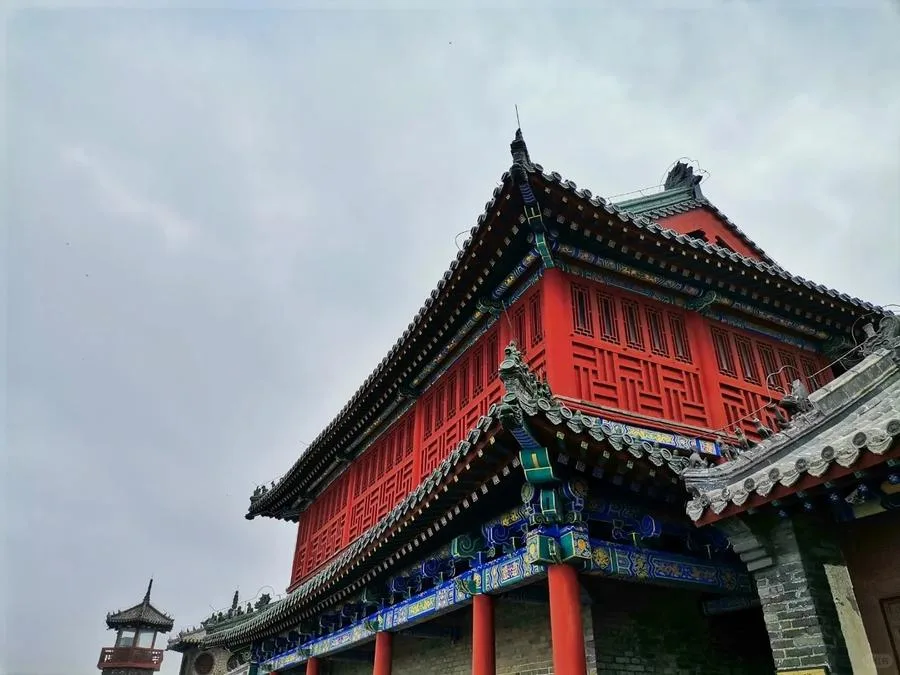
Situated south of the Guest Hall, Lvzu Temple (吕祖殿) faces north and consists of a main gate, main hall, and east and west wings, all built in the temple architectural style. During the Qing Dynasty under the administration of Prefect Jia Hu and General Wang Zhengqi, the main hall was constructed with a rigid mountain structure spanning three rooms. It integrates with the Guest Hall to the north, measuring 9.04 meters in length and 8.05 meters in depth. Inside the hall, a high platform shrine houses a seated statue of Lü Dongbin, the Pure Yang Emperor, flanked by attendant figures of Daoist acolytes and spirit trees.
Sanqing Hall
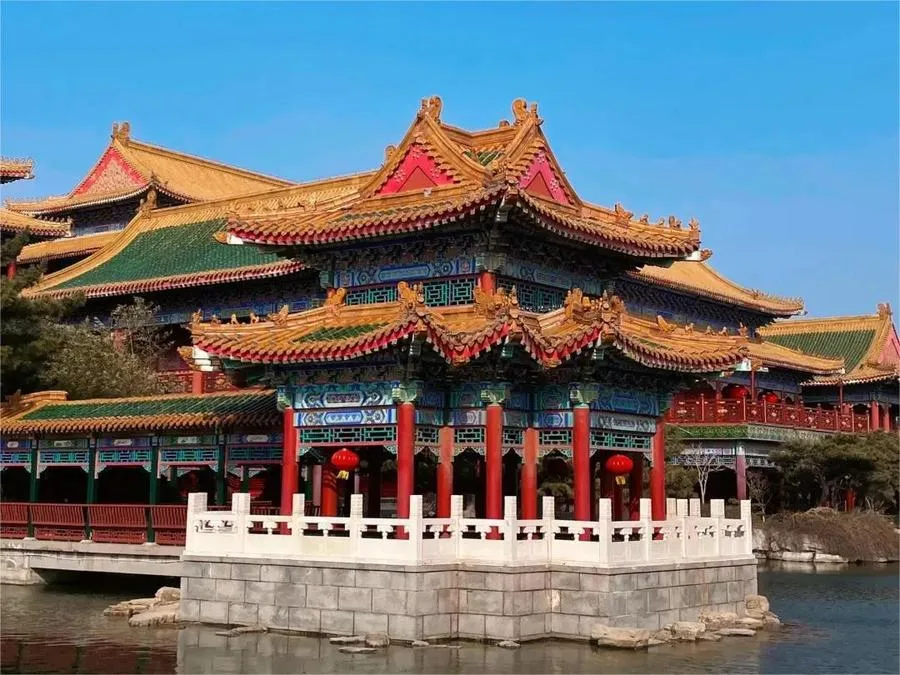
Located at the northern end of the courtyard inside the main gate of Baiyun Palace, behind the Immortal Realm Arch, Sanqing Hall (三清殿) is dedicated to the Taoist deities Yuan Shi Tian Zun, Ling Bao Tian Zun, and Dao De Tian Zun. Initially built during the Tang Dynasty in the Kaiyuan era, the main structures include the front hall and the main hall, both built in traditional temple architecture. The front hall measures 10.90 meters in length and 6.85 meters in depth, featuring four prominent columns in the outer corridor and four golden columns inside. Flanking the hall entrance are statues of the guardian gods: Chen Qi on the left and Zheng Lun on the right. The main hall stretches 13.53 meters in length and 10.10 meters in depth, adorned with dragon-hung lotus curtains outside and fourteen golden columns inside.
Wind Shelter Pavilion
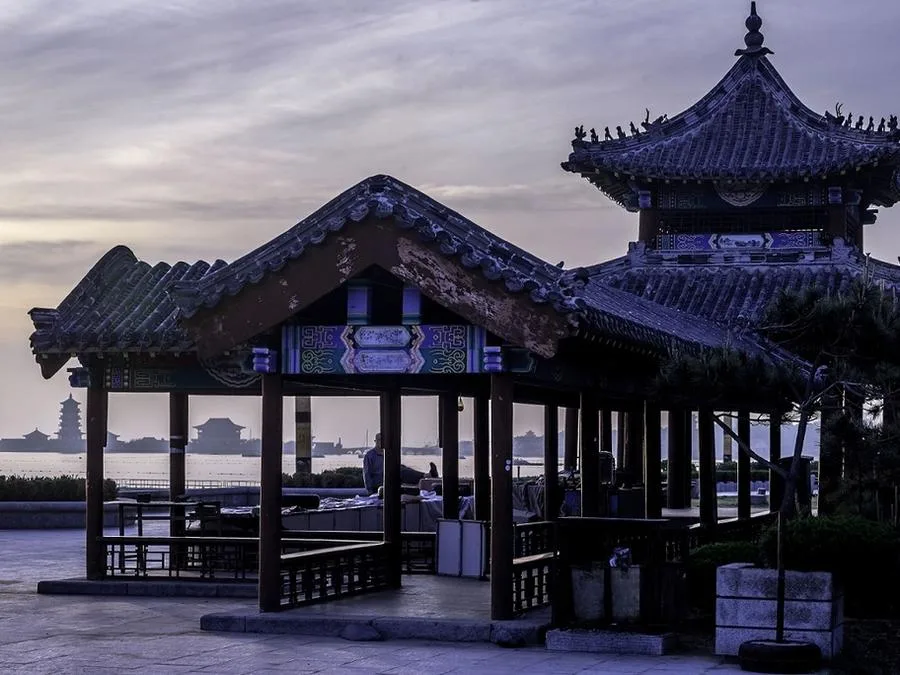
Situated in the western part of Penglai Pavilion (避风亭), the Wind Shelter Pavilion, originally known as the Sea Market Pavilion, is a pavilion-style building. Positioned strategically against a sheer cliff face, it effectively blocks winds sweeping from the sea, creating a calm space. The pavilion lacks a southern window, forming a dead zone that blocks the airflow, hence providing protection from strong gusts. Inside, the walls are adorned with 25 engraved stones, including poems by Yuan Keli of the Ming Dynasty, calligraphy by Dong Qichang, and inscriptions by Wen Ruyu, showcasing their artistic prowess. Additionally, the pavilion features handwriting by Shi Runzhang and Kong Jisu from the Qing Dynasty, adding to its cultural significance as a historical site.
Binri Tower
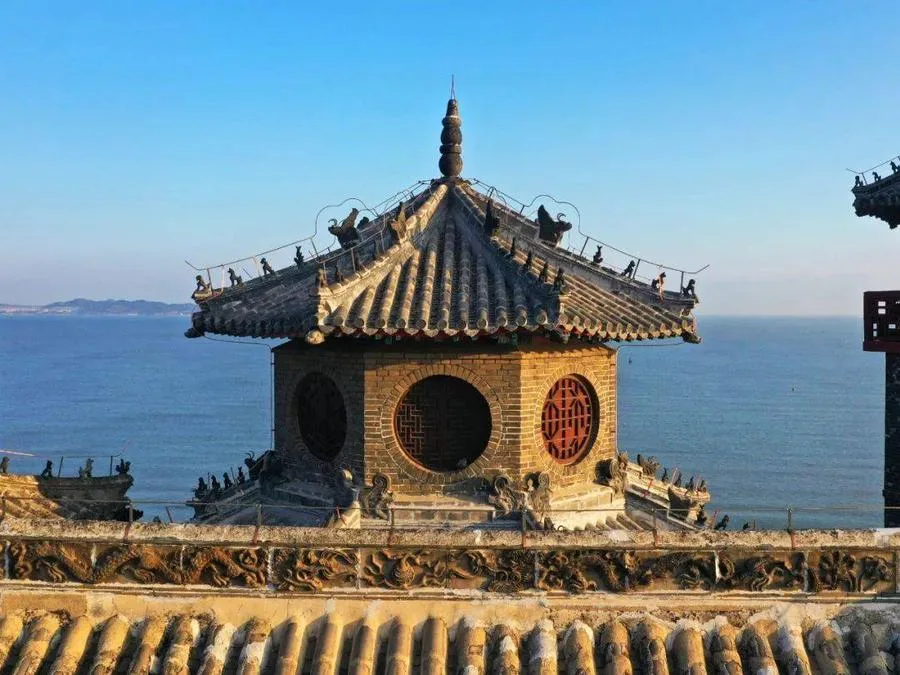
Also known as the Watching-the-Sunrise Tower, Binri Tower (宾日楼) is an octagonal, two-story brick and wood structure supported by sixteen columns. Adjacent to Lvzu Hall on its southern side, the tower features an outer corridor on the ground floor and a spiral wooden staircase leading upwards. The second floor is adorned with eight circular windows, providing panoramic views of all directions and capturing winds from all sides. It is renowned as an ideal spot to witness the sunrise over the sea, offering spectacular views known as “Rising Sun over the Eastern Sea.”
Puzhao Tower

Located at the northeast corner of Penglai Pavilion, Puzhao Tower (普照楼) , also called the Lantern Tower, was historically used as a navigational beacon for nighttime boat travel. This three-story brick and wood structure covers an area of 25 square meters and features a hexagonal roof with arches. Inside, a spiral staircase leads to the upper floors. The topmost level is constructed with wooden columns resembling a pavilion, surrounded by wooden railings. Originally serving as a guiding light for ships, its navigation role diminished with the introduction of the Tianhengshan Beacon Tower.
Penglai Pavilion Temple Fair

The Penglai Pavilion Temple Fair is a provincial-level intangible cultural heritage event in Shandong Province and one of the most significant temple fairs in the Jiaodong region. It integrates Taoist culture, Buddhist culture, folk customs, traditional crafts, modern culture, commerce, culinary delights, and maritime culture into a vibrant celebration, embodying rich local traditions.
Celebrated annually on the 16th day of the first lunar month, which marks the birthday of the Heavenly Queen Mother, the fair has been observed since the Northern Song Dynasty. People from all corners flock to the Tianhou Palace on Danxia Mountain to pay homage, make offerings, seek blessings through divination, and donate money for temple upkeep.
During the fair, rural communities organize opera performances and yangge dances within the Tianhou Palace courtyard, while large-scale yangge performances take place on the square below Penglai Pavilion. After paying respects to the Heavenly Queen Mother, visitors enjoy watching operas with family and friends in the palace courtyard, witnessing yangge dances on the square, and shopping for various small goods. Many also take the opportunity to explore Penglai Pavilion and nearby attractions until they are thoroughly satisfied, continuing a tradition that has endured through generations.
Legends about Penglai pavilion
Seeking the Elixir of Immortality
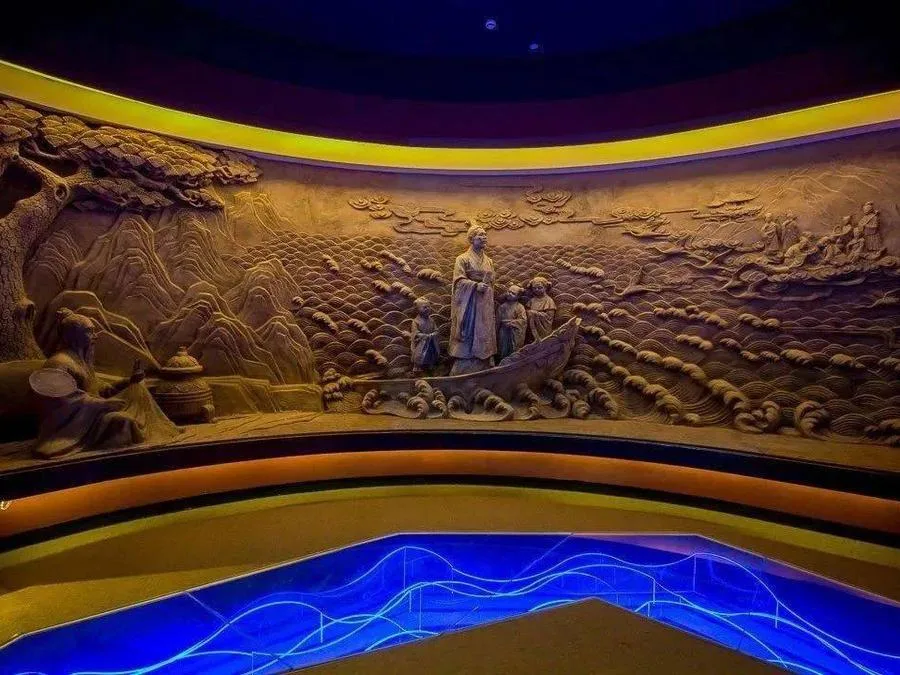
Legend has it that long ago, there were three sacred mountains in the Bohai Sea, where everything was white and palaces of gold and silver stood. It was believed that consuming substances from these mountains granted immortality. Emperor Qin Shi Huang, after unifying the six states of China, sought to secure his empire and his personal longevity. Inspired by the tales of these mountains, he journeyed to Penglai Pavilion in search of the fabled elixir of immortality. Xu Fu, a court sorcerer, was dispatched by the emperor to sail into the East Sea in search of the elixir. Historical records also mention Emperor Han Wu Di’s quest for the elixir in this same place.
The Eight Immortals Crossing the Sea
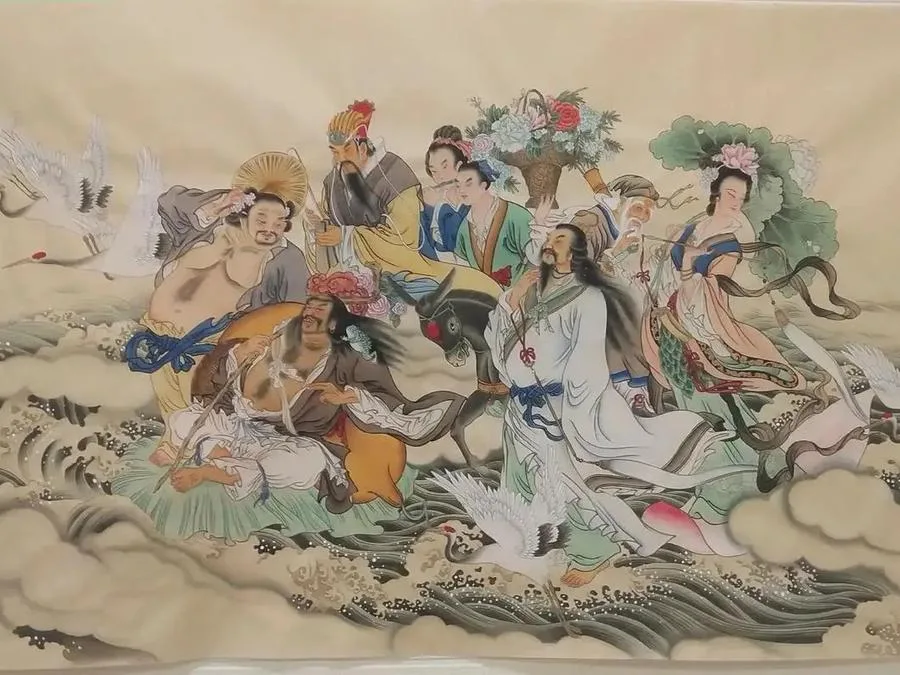
Another famous legend associated with Penglai Pavilion is that of the Eight Immortals crossing the sea. Once, the Eight Immortals gathered at Penglai Pavilion for a feast and wine. As the merriment grew, Tieguai Li proposed a spontaneous trip to the sea. All the immortals agreed but with a condition—they would use their magical powers to cross the sea without using boats.
Han Zhongli took out a large banana leaf fan and threw it into the sea. He reclined on the fan with his bare chest and abdomen exposed, floating effortlessly into the distance. He Xian Gu tossed a lotus flower into the water, and instantly, a thousand red beams of light appeared. She sat gracefully atop the lotus, drifting with the waves. Following suit, Lu Dongbin, Zhang Guolao, Cao Guojiu, Tieguai Li, Han Xiangzi, and Lan Caihe each threw their respective treasures into the sea, showcasing their magical abilities as they crossed into the East Sea.
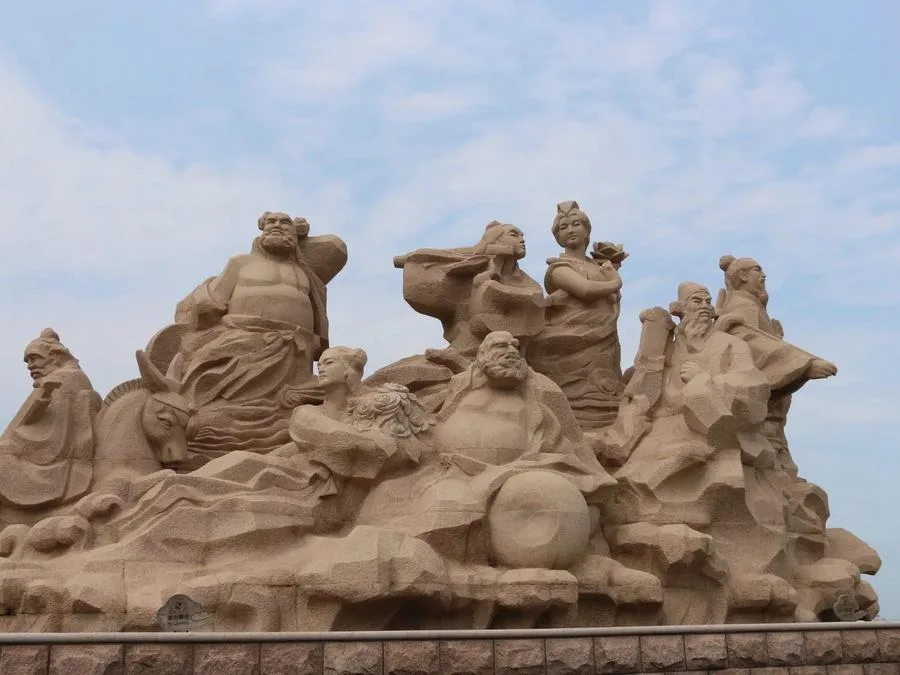
Their actions, however, alarmed the Dragon King of the East Sea, who sent his army of shrimp soldiers and crab generals to investigate. A conflict ensued when the Dragon King captured Lan Caihe and took them to his palace. Enraged, the other immortals fought back, showcasing their formidable powers. They even managed to slay two dragon princes, causing chaos in the sea.
In retaliation, the Dragon King summoned the Dragon Kings from the South, North, and West Seas, causing massive waves and turmoil. In the midst of this peril, Cao Guojiu used his jade tablet to calm the waters, creating a path through the raging waves. The immortals followed closely behind, escaping unscathed.
Just as the four Dragon Kings prepared for a decisive battle, Guanyin Bodhisattva of the South Sea appeared and intervened. She mediated between the immortals and the Dragon King until Lan Caihe was released and peace was restored. The Eight Immortals bid farewell to Guanyin Bodhisattva, each holding their treasures, and continued their journey across the waves, leaving behind a tale of adventure and divine intervention in the waters near Penglai Pavilion.
Vlog about Penglai Pavilion Scenic Area
History of Penglai Pavilion
Early Beginnings
The history of Penglai Pavilion dates back to the Tang Dynasty (7th century AD). According to legend, during the reign of Emperor Taizong of Tang, fishermen on Danxia Mountain (the present site of Penglai Pavilion) established a temple dedicated to Prince Guangde, while Buddhist monks founded the Mituo Temple at the southern foot of the mountain.
Tang and Song Dynasties
In the Tang Dynasty, a Taoist temple dedicated to the Three Pure Ones (Sanqing) was constructed east of the Guangde Temple. During the Northern Song Dynasty (1061 AD), the governor of Dengzhou, Zhu Chuyue, relocated the Guangde Temple westward and began construction of the Dragon King Palace on its original site, which marked the beginning of the Penglai Pavilion. A commemorative inscription was erected to establish Penglai Pavilion as a place for local residents and travelers alike.
Cultural Flourishing in the Song and Ming Dynasties
Throughout the Song and Ming Dynasties, Penglai Pavilion underwent numerous expansions and renovations under various governors and officials. Notably, figures such as Su Shi (Su Dongpo) and other literati of the Song Dynasty left behind poetic and literary works praising the scenic beauty of Penglai Pavilion and its surroundings. The pavilion became a center of cultural and religious activities, with temples dedicated to sea gods and local deities.
Turmoil and Reconstruction in the Qing Dynasty
During the Qing Dynasty, Penglai Pavilion faced challenges from natural disasters and military conflicts. The pavilion and its surrounding structures were repeatedly damaged and rebuilt. For instance, in the early 19th century, significant efforts were made to restore and enhance the pavilion’s grandeur, including the construction of additional buildings such as the Bibi Pavilion and the renovation of existing structures like the Dragon King Palace.
Modern Era and Preservation Efforts
In the 20th century, especially during the turbulent periods of the Republic of China era and subsequent wars, Penglai Pavilion suffered extensive damage. However, concerted restoration efforts began in the mid-20th century, focusing on preserving its architectural integrity and cultural significance. Government funding and cultural heritage initiatives played pivotal roles in these efforts, ensuring that Penglai Pavilion remains a cherished historical and cultural landmark.

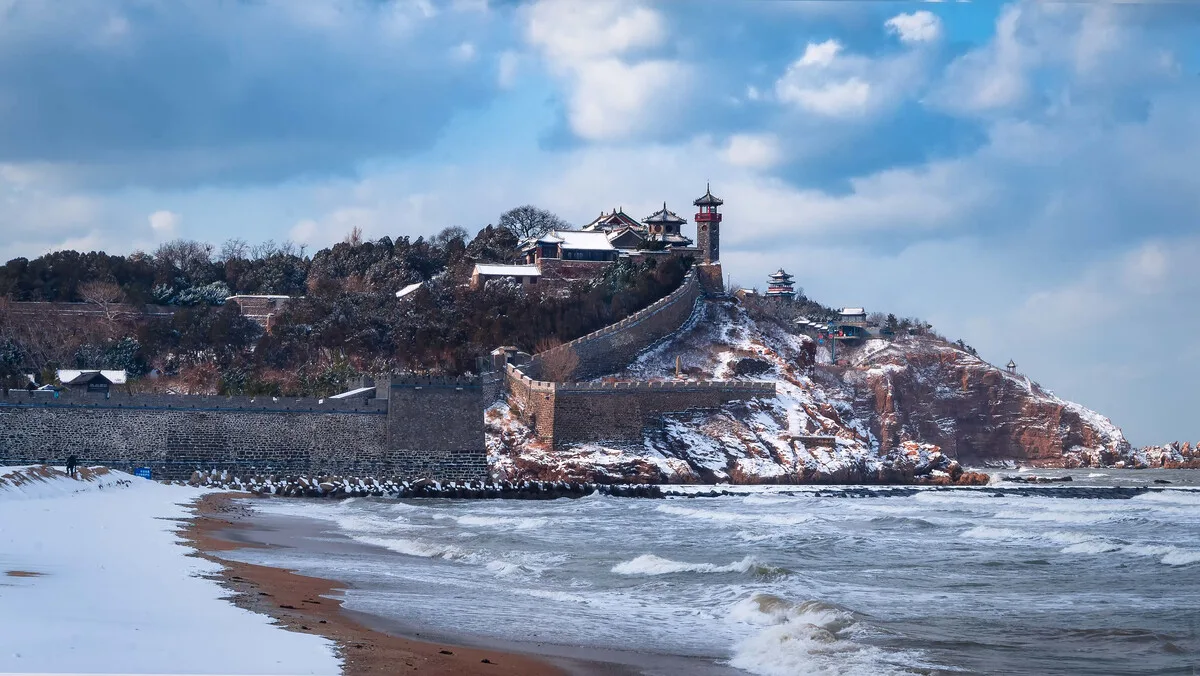




The ancient architecture of the Penglai Pavilion Scenic Area is stunning; every snapshot feels like a masterpiece!
At the beginning of April, the scenery at Penglai Pavilion was just average. I believe it will be much more beautiful in May, as many trees are still bare right now. If you’re interested in understanding the history of Qi Jiguang’s resistance against the Japanese pirates and the legends of the Eight Immortals, I recommend hiring a guide at the entrance. Otherwise, you’ll just be visiting the exhibition halls and ancient architectural complex. You can take a walk along the… Read more »
At 4°C, it’s still okay when we are not close to the seaside! However, the closer you are to the coast, the stronger and colder the winds become! But once you step inside the Penglai Pavilion, there’s no wind, and it feels a bit warmer! I can imagine that in summer, with lush greenery, the scenery would be even more beautiful! However, each season offers its own unique beauty.
It’s similar to the seafront in Yantai Zhifu and Muping, but everywhere you go, you have to pay, and the tickets are really expensive. The key point is that it’s not enjoyable at all; it’s the most disappointing place I’ve been to among all the destinations. The ticket price for Penglai Pavilion, a 5A scenic area, is so high, but in reality, it’s not even as good as the East Fort of Yantai, which is just a park worth thirty… Read more »
In the morning, I first visited Penglai Pavilion. The heavy snowfall made the park quite empty, and I hardly saw anyone along the path I took. The ground was covered in a blanket of white, creating a rare sense of tranquility that was truly enchanting. As I climbed the stairs, ancient architecture started to appear before my eyes. Without a tour guide or audio guide, I simply indulged in the moment of peace and the serene snowy landscape.
Penglai Pavilion has finally welcomed the first snowfall of the winter. Although the snow is light, it creates a dreamy and enchanting atmosphere, giving the pavilion a winter makeover. The vermilion structure looks even more dignified and lively against the backdrop of the white snow.
The ticket price of 100 is acceptable to me. The 100 yuan ticket includes beautiful ocean views, a cluster of ancient buildings, the Qi Jiguang Museum, and the Ancient Ship Museum. I spent a total of 6 hours exploring everything and barely took any breaks.
The cable car at Penglai Pavilion is still under maintenance and may not be open until the National Day holiday. The lighthouse at Tianheng Mountain is also undergoing repairs, so currently, access to the plank road and the boundary square between the Yellow Sea and the Bohai Sea is not possible.